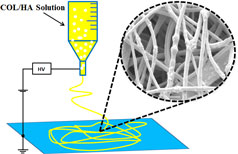Crossref Citations
This article has been cited by the following publications. This list is generated based on data provided by
Crossref.
Liverani, Liliana
Vester, Lars
and
Boccaccini, Aldo R.
2017.
Electrospun Biomaterials and Related Technologies.
p.
149.
Ayala-Caminero, Radamés
Pinzón-Herrera, Luis
Rivera Martinez, Carol A.
and
Almodovar, Jorge
2017.
Polymeric scaffolds for three-dimensional culture of nerve cells: a model of peripheral nerve regeneration.
MRS Communications,
Vol. 7,
Issue. 3,
p.
391.
Castilla-Casadiego, David A.
Rivera-Martínez, Carol A.
Quiñones-Colón, Beatriz A.
and
Almodóvar, Jorge
2017.
Electrospun Biomaterials and Related Technologies.
p.
21.
Castilla-Casadiego, David A.
Pinzon-Herrera, Luis
Perez-Perez, Maritza
Quiñones-Colón, Beatriz A.
Suleiman, David
and
Almodovar, Jorge
2018.
Simultaneous characterization of physical, chemical, and thermal properties of polymeric multilayers using infrared spectroscopic ellipsometry.
Colloids and Surfaces A: Physicochemical and Engineering Aspects,
Vol. 553,
Issue. ,
p.
155.
Crabbe-Mann, M.
Tsaoulidis, D.
Parhizkar, M.
and
Edirisinghe, M.
2018.
Ethyl cellulose, cellulose acetate and carboxymethyl cellulose microstructures prepared using electrohydrodynamics and green solvents.
Cellulose,
Vol. 25,
Issue. 3,
p.
1687.
Kesici Güler, Hülya
Cengiz Çallıoğlu, Funda
and
Sesli Çetin, Emel
2019.
Antibacterial PVP/cinnamon essential oil nanofibers by emulsion electrospinning.
The Journal of The Textile Institute,
Vol. 110,
Issue. 2,
p.
302.
CENGİZ ÇALLIOĞLU, Funda
and
KESİCİ GÜLER, Hülya
2019.
Fabrication of Polyvinylpyrrolidone Nanofibers with Green Solvents.
Süleyman Demirel Üniversitesi Fen Edebiyat Fakültesi Fen Dergisi,
Vol. 14,
Issue. 2,
p.
352.
Bian, Tierong
Zhao, Kang
Meng, Qingnan
Tang, Yufei
Jiao, Hua
and
Luo, Jing
2019.
The construction and performance of multi-level hierarchical hydroxyapatite (HA)/collagen composite implant based on biomimetic bone Haversian motif.
Materials & Design,
Vol. 162,
Issue. ,
p.
60.
Bongiovanni Abel, Silvestre
Liverani, Liliana
Boccaccini, Aldo R.
and
Abraham, Gustavo A.
2019.
Effect of benign solvents composition on poly(ε-caprolactone) electrospun fiber properties.
Materials Letters,
Vol. 245,
Issue. ,
p.
86.
Bian, Tierong
Zhang, Heng
and
Xing, Hongyun
2020.
Preparation and biological properties of collagen/nano-hydroxyapatite composite nanofibers based on ordered nano-hydroxyapatite ceramic fibers.
Colloids and Surfaces A: Physicochemical and Engineering Aspects,
Vol. 602,
Issue. ,
p.
124802.
Castilla-Casadiego, David A.
Timsina, Hemanta
Haseli, Mahsa
Pinzon-Herrera, Luis
Chiao, Yu-Hsuan
Wickramasinghe, S. Ranil
and
Almodovar, Jorge
2020.
Methods for the Assembly and Characterization of Polyelectrolyte Multilayers as Microenvironments to Modulate Human Mesenchymal Stromal Cell Response.
ACS Biomaterials Science & Engineering,
Vol. 6,
Issue. 12,
p.
6626.
Reyes-Ramos, Ana M.
Álvarez-García, Yasmín R.
Solodin, Natalia
Almodovar, Jorge
Alarid, Elaine T.
Torres-Garcia, Wandaliz
and
Domenech, Maribella
2021.
Collagen I Fibrous Substrates Modulate the Proliferation and Secretome of Estrogen Receptor-Positive Breast Tumor Cells in a Hormone-Restricted Microenvironment.
ACS Biomaterials Science & Engineering,
Vol. 7,
Issue. 6,
p.
2430.
Veiga, Anabela
Castro, Filipa
Rocha, Fernando
and
Oliveira, Ana L.
2022.
An update on hydroxyapatite/collagen composites: What is there left to say about these bioinspired materials?.
Journal of Biomedical Materials Research Part B: Applied Biomaterials,
Vol. 110,
Issue. 5,
p.
1192.
Falsafi, Seid Reza
Topuz, Fuat
Esfandiari, Zahra
Can Karaca, Asli
Jafari, Seid Mahdi
and
Rostamabadi, Hadis
2023.
Recent trends in the application of protein electrospun fibers for loading food bioactive compounds.
Food Chemistry: X,
Vol. 20,
Issue. ,
p.
100922.
Flores-Rojas, Guadalupe Gabriel
Gómez-Lazaro, Bélen
López-Saucedo, Felipe
Vera-Graziano, Ricardo
Bucio, Emilio
and
Mendizábal, Eduardo
2023.
Electrospun Scaffolds for Tissue Engineering: A Review.
Macromol,
Vol. 3,
Issue. 3,
p.
524.
Feng, Yashan
Shi, Yanhong
Tian, Yafang
Yang, Yongxin
Wang, Jun
Guo, Haiwei
Banitaba, Seyedeh Nooshin
Khademolqorani, Sanaz
and
Li, Jing’an
2023.
The Collagen-Based Scaffolds for Bone Regeneration: A Journey through Electrospun Composites Integrated with Organic and Inorganic Additives.
Processes,
Vol. 11,
Issue. 7,
p.
2105.
Shen, Rujun
Guo, Yunlong
Wang, Shuaijie
Tuerxun, Ayikezi
He, Jiaqi
and
Bian, Ye
2023.
Biodegradable Electrospun Nanofiber Membranes as Promising Candidates for the Development of Face Masks.
International Journal of Environmental Research and Public Health,
Vol. 20,
Issue. 2,
p.
1306.
Boonyaritthongchai, P.
Kebngon, C.
Khumthongwattana, M.
Wongs-Aree, C.
Supapvanich, S.
and
Tepsorn, R.
2024.
Production of cinnamon essential oil-loaded electrospun nanofiber for postharvest technology application usage.
Acta Horticulturae,
p.
461.
Uddin, Md Nur
Ali, Ayub
Jobaer, Md
Mahedi, Sajjatul Islam
Krishnamoorthy, Anand
and
Bhuiyan, M. A. Rahman
2024.
Electrospun nanofibers based on plant extract bioactive materials as functional additives: possible sources and prospective applications.
Materials Advances,
Vol. 5,
Issue. 20,
p.
7862.
Gutierrez-Rivera, Jhonatan A.
Roca-Arroyo, Andres F.
Castilla-Casadiego, David A.
and
Albis, Alberto
2025.
Development of a low-cost electrospinning system with a bidirectional collector for uniform nanofibrous membranes.
HardwareX,
Vol. 24,
Issue. ,
p.
e00704.



